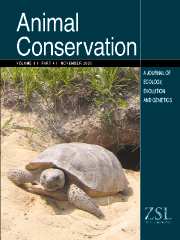Crossref Citations
This article has been cited by the following publications. This list is generated based on data provided by
Crossref.
Armstrong, Doug P
and
Ewen, John G
2001.
Assessing the value of follow-up translocations.
Biological Conservation,
Vol. 101,
Issue. 2,
p.
239.
Steury, Todd D.
and
Murray, Dennis L.
2004.
Modeling the reintroduction of lynx to the southern portion of its range.
Biological Conservation,
Vol. 117,
Issue. 2,
p.
127.
Pedrono, Miguel
Smith, Lora L
Clobert, Jean
Massot, Manuel
and
Sarrazin, François
2004.
Wild-captive metapopulation viability analysis.
Biological Conservation,
Vol. 119,
Issue. 4,
p.
463.
Bretagnolle, Vincent
and
Inchausti, Pablo
2005.
Modelling population reinforcement at a large spatial scale as a conservation strategy for the declining little bustard (Tetrax tetrax) in agricultural habitats.
Animal Conservation,
Vol. 8,
Issue. 1,
p.
59.
Bar-David, Shirli
Saltz, David
and
Dayan, Tamar
2005.
PREDICTING THE SPATIAL DYNAMICS OF A REINTRODUCED POPULATION: THE PERSIAN FALLOW DEER.
Ecological Applications,
Vol. 15,
Issue. 5,
p.
1833.
Varley, Nathan
and
Boyce, Mark S.
2006.
Adaptive management for reintroductions: Updating a wolf recovery model for Yellowstone National Park.
Ecological Modelling,
Vol. 193,
Issue. 3-4,
p.
315.
Bar-David, Shirli
Lloyd-Smith, James O.
and
Getz, Wayne M.
2006.
DYNAMICS AND MANAGEMENT OF INFECTIOUS DISEASE IN COLONIZING POPULATIONS.
Ecology,
Vol. 87,
Issue. 5,
p.
1215.
Harding, Lee E.
Abu-Eid, Omar F.
Hamidan, Nashat
and
al Sha'lan, Ahmad
2007.
Reintroduction of the Arabian oryxOryx leucoryxin Jordan: war and redemption.
Oryx,
Vol. 41,
Issue. 4,
p.
478.
Nicholson, Teri E.
Mayer, Karl A.
Staedler, Michelle M.
and
Johnson, Andrew B.
2007.
Effects of rearing methods on survival of released free-ranging juvenile southern sea otters.
Biological Conservation,
Vol. 138,
Issue. 3-4,
p.
313.
DIMOND, WENDY J.
and
ARMSTRONG, DOUG P.
2007.
Adaptive Harvesting of Source Populations for Translocation: a Case Study with New Zealand Robins.
Conservation Biology,
Vol. 21,
Issue. 1,
p.
114.
Bar-David, Shirli
Saltz, David
Dayan, Tamar
and
Shkedy, Yehoshua
2008.
Using spatially expanding populations as a tool for evaluating landscape planning: The reintroduced Persian fallow deer as a case study.
Journal for Nature Conservation,
Vol. 16,
Issue. 3,
p.
164.
Gilad, Oranit
Grant, William E.
and
Saltz, David
2008.
Simulated dynamics of Arabian Oryx (Oryx leucoryx) in the Israeli Negev: Effects of migration corridors and post-reintroduction changes in natality on population viability.
Ecological Modelling,
Vol. 210,
Issue. 1-2,
p.
169.
Marder, Ofer
Yeshurun, Reuven
Lupu, Ronit
Bar‐Oz, Guy
Belmaker, Miriam
Porat, Naomi
RON, Hagai
and
Frumkin, Amos
2011.
Mammal remains at Rantis Cave, Israel, and Middle–Late Pleistocene human subsistence and ecology in the Southern Levant.
Journal of Quaternary Science,
Vol. 26,
Issue. 8,
p.
769.
BERGER‐TAL, ODED
BAR‐DAVID, SHIRLI
and
SALTZ, DAVID
2012.
Effectiveness of Multiple Release Sites in Reintroduction of Persian Fallow Deer.
Conservation Biology,
Vol. 26,
Issue. 1,
p.
107.
Converse, Sarah J.
Moore, Clinton T.
and
Armstrong, Doug P.
2013.
Demographics of reintroduced populations: Estimation, modeling, and decision analysis.
The Journal of Wildlife Management,
Vol. 77,
Issue. 6,
p.
1081.
Polak, T.
Gutterman, Y.
Hoffman, I.
and
Saltz, D.
2014.
Redundancy in seed dispersal by three sympatric ungulates: a reintroduction perspective.
Animal Conservation,
Vol. 17,
Issue. 6,
p.
565.
Goudarzi, F.
Hemami, M. R.
Bashari, H.
and
Johnson, S.
2015.
Assessing translocation success of the endangered Persian fallow deer using a Bayesian Belief Network.
Ecosphere,
Vol. 6,
Issue. 10,
p.
1.
Schmitz, Philip
Caspers, Stephanie
Warren, Paige
Witte, Klaudia
and
Lepczyk, Christopher A.
2015.
First Steps into the Wild – Exploration Behavior of European Bison after the First Reintroduction in Western Europe.
PLOS ONE,
Vol. 10,
Issue. 11,
p.
e0143046.
Todd, Charles R.
and
Lintermans, Mark
2015.
Who do you move? A stochastic population model to guide translocation strategies for an endangered freshwater fish in south-eastern Australia.
Ecological Modelling,
Vol. 311,
Issue. ,
p.
63.
Batson, William G.
Gordon, Iain J.
Fletcher, Donald B.
Manning, Adrian D.
and
Hayward, Matt
2015.
REVIEW: Translocation tactics: a framework to support the IUCN Guidelines for wildlife translocations and improve the quality of applied methods.
Journal of Applied Ecology,
Vol. 52,
Issue. 6,
p.
1598.


